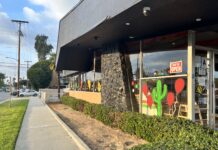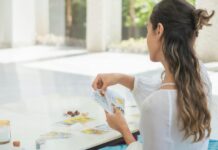
Thomas Holguin/UCR
Professor Richard Cardullo is a monumental figure at UCR whose name can be heard in all corners of the campus. He began as a professor of biology 26 years ago, researching the process of fertilization in animals as well as student learning in K-12 environments. Then, after receiving numerous awards in teaching and serving as the chair of the department of biology from 2004 to 2009, and a divisional dean in CNAS from 2009 to 2012, he became the Howard H Hays Jr. Chair of University Honors in 2014. As the faculty director of Honors, Cardullo has motivated students to strive to be more civically engaged by offering a series of diverse lectures that encourage multiple perspectives and interactive discussion. Just this year, he was appointed as the interim vice provost for undergraduate education through which he will continue to improve the learning experience of students at UCR.
The Highlander was granted the opportunity to talk to Cardullo about his experience working closely with students as both a professor and an advisor working to improve the educational environment across campus.
The discussion has been lightly edited for clarity.
Jasmine: How did you cultivate the different pillars of the Honors system for the students you have interacted with through the classroom and personally?
Prof. Cardullo: It is actually a group effort. It’s not only individually working with the students but also the amazing group of University Honors counselors. It’s working as a team and understanding what our roles are to come up with what we think are the best programs for our students. It’s a very holistic approach and the Honors program is much different than what it was even five or six years ago. It’s constantly changing because the world changes and students change and faculty change, so we are compelled to evolve.
Jasmine: In your lectures, how do you get students to be more engaged with one another and the Honors system beyond the classroom?
Prof. Cardullo: That is by design and that is not always easy because Honors is multi-disciplinary. The challenge is having all students realize that there is value in having people talk about common problems from different perspectives. And each perspective really adds something to the conversation. The class I taught this fall, Honors 2A, was a civic engagement class and I chose the theme of climate change. In each class I looked at it from a different lens: The lens of a scientist, the lens of a humanist, the lens of someone who is interested in social justice. The fun thing was that my knowledge in this area was limited so I learned much of it along the way so that I could teach it. In that way, I modeled the class around what it means to be a life-long learner and then I could learn even more from the students’ perspectives. In the workshops, we ask students to go even deeper and there we really want them to be interactive and involved. Some weeks they may do research and give a presentation. Other times, they may engage in a debate. Regardless, we have them work together in hopes that they will come to appreciate different perspectives.
Jasmine: Do you think all classes beyond Honors should be designed to be deliberately cultivating toward multiple perspectives?
Prof. Cardullo: Yes, in a sense. A lot of research over many decades has focused on what makes an effective teacher and an effective learner. One of the things that we know is that students retain very little information in a standard lecture format. And yet, we still do it and I still do it sometimes. The more effective way is to engage students and have them work together in groups. The acquisition of knowledge is easy — any student can pick up a tablet and get information instantaneously — but given that ability, we can then raise teaching to the next level and ask what you can do with that knowledge. That’s what makes learning fun: The ability to apply it.
Jasmine: What does the ideal classroom look like to you?
Prof. Cardullo: If I were to enter a classroom, not knowing what was being taught, not knowing the material of the course, and I see the teacher facilitating learning — lots of activity, lots of discussion, lots of application, evidence of creativity or seeing the teacher actively interacting with students — that is the ideal classroom. Seeing that engagement from both the student and the teacher. We are actually designing classrooms starting this summer that will facilitate this kind of interaction between students and professors. We are changing the physical design of these classrooms by asking questions such as, “What does the ideal classroom look like? What will a classroom that facilitates active learning look like?” and from there, we create the nuts and bolts: Classrooms with more writing spaces, more open space to move around in, chairs that move so students can look around more as the teacher moves so there’s not just straight-staring at the front of the room.
The acquisition of knowledge is easy — any student can pick up a tablet and get information instantaneously — but given that ability, we can then raise teaching to the next level and ask what you can do with that knowledge. That’s what makes learning fun: The ability to apply it.
Jasmine: Would you say that some of your research about learning in K-12 environments has inspired some of your own methods and different ways of teaching at UCR?
Prof. Cardullo: With my research, it is hard to say. It is more of from my interaction with the students, especially with young children. Children are natural scientists and they’re not afraid. They want to play. University students … it’s sometimes more difficult. It often takes more effort to get them to engage; they have to feel safe first, which I understand completely but it’s much the same thing. The one exception may have been one research project that looked at how different cultures might learn more effectively — in particular, how some cultures ultimately influence how teachers and students interact. We looked into how developing a safe, trusting relationship ultimately impacts the self-efficacy of those students. So it made me realize that if I see those populations here at UCR, I need to start thinking not about the differences in background in terms of what courses they have had but rather how these other experiences that students have impact the way they learn.
Jasmine: Do these efforts that impact the way students and teachers interact and connect to the renovations in classrooms that will be taking place this summer, such as with the added moving space and writing surfaces?
Prof. Cardullo: Yes, absolutely. We were having conversations with architects even earlier today and years from now, we will learn from these changes by measuring the progress so that we can see how we can change other buildings and classrooms. And it’s not just a single classroom but also we’re thinking about how entire buildings should change. So now we go from having standard buildings that have classrooms to, for instance, what does it mean to bring living and learning spaces together? It is possible that a few years from now, that some students won’t have to go very far, like just down the hall in their residence to go to their classroom. This is actually happening all over the world and is not necessarily new. Even when I was a student, teachers would hold classes in some of the residence halls. Those were very powerful learning environments and even in some living structures like those in Glen Mor, there are spaces that could be used as classrooms. They’re small, but they’re interactive spaces for learning environments.
Jasmine: In terms of being the vice interim provost of undergraduate education, what is your main objective?
Prof. Cardullo: My main objective is simple: It’s that all students get a high-quality educational experience that gives them the opportunity to be successful — not just here at UCR but beyond. I’ve been here for 26 years and from all of the institutions I have ever been to, this one is by far my favorite. This university has always had a unique energy: An energy that starts with the students but you can feel the pulse in the staff, in the faculty, in the community. It’s unique in my experience. I’ve liked the other institutions that I came from very much but there’s nothing like UCR. It starts with the students.
Jasmine: Why do you think we in particular hold this special energy?
Prof. Cardullo: Well, I think one of the factors is frankly the diversity. One of the things I love about this institution is that it is not only the students but also the faculty that have a story to tell — if they are given that opportunity. We know that a large fraction of our students are first-generation college students but many people don’t realize that a lot of our faculty members and staff were also first-generation students. Getting those people to tell their stories about what it means to be first-generation is powerful and it empowers students to basically say, “If they could harness all of that energy and passion, I can too.” And what’s really exciting is that the students also fuel the energy for faculty. Research is a two-way street: Research informs our teaching, but teaching also informs our research. I’ll give an example: I’m a reproductive biologist and a biophysicist and I always have students in my lab because they are fascinated with what I research related to the basic science behind the beginning of life. Some have had a class with me, others haven’t but once they’re in the lab, they realize they’re in another teaching environment and then at some point, if they’re with us long enough, there’s a wonderful transition in which they evolve from a student to the teacher. That is perhaps the most exciting aspect of being a professor because you get to see another chapter being added to that student’s personal story.








